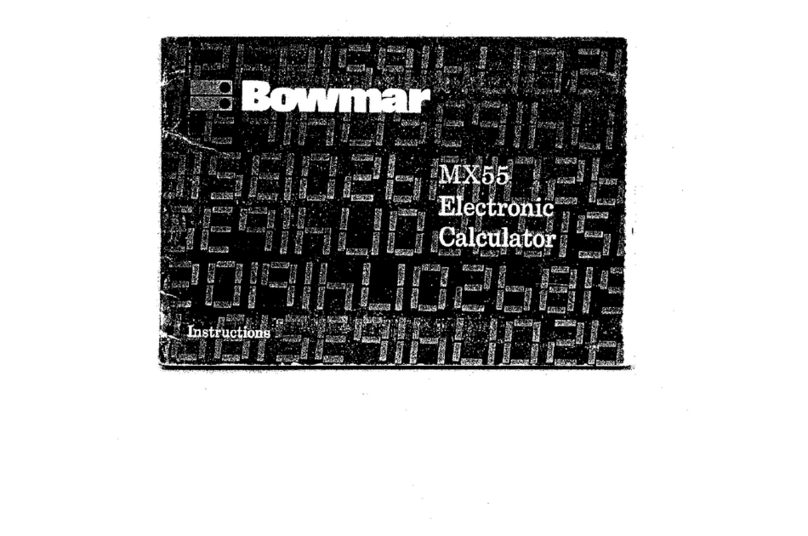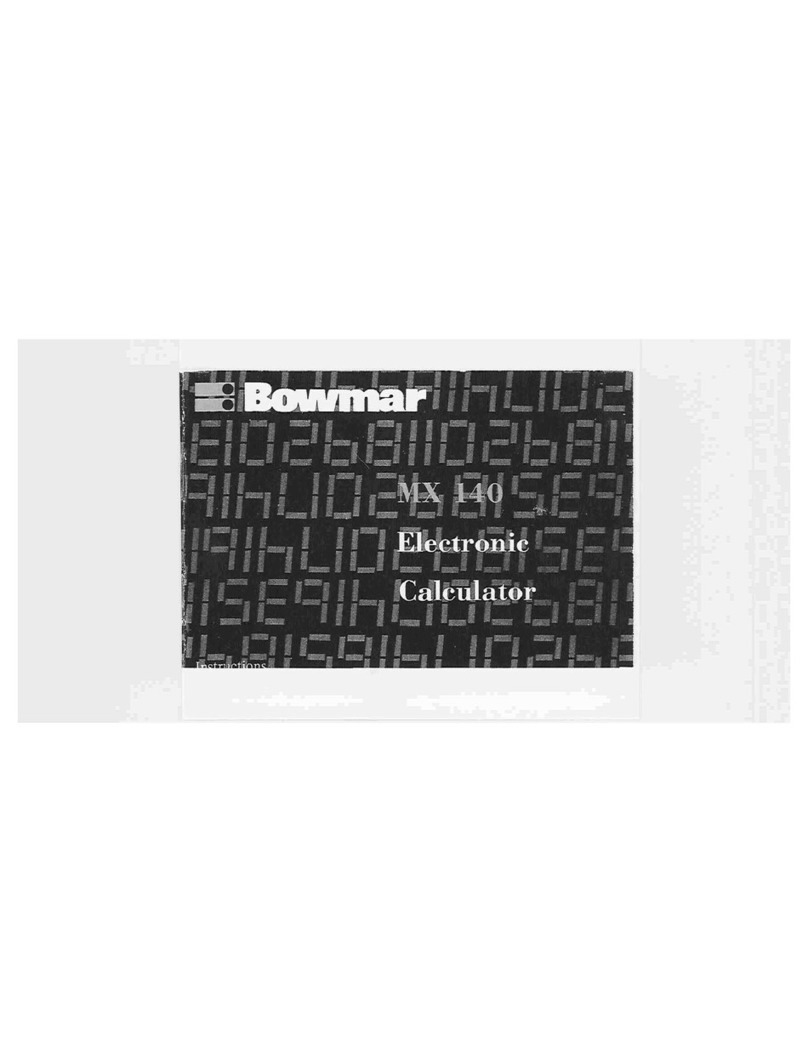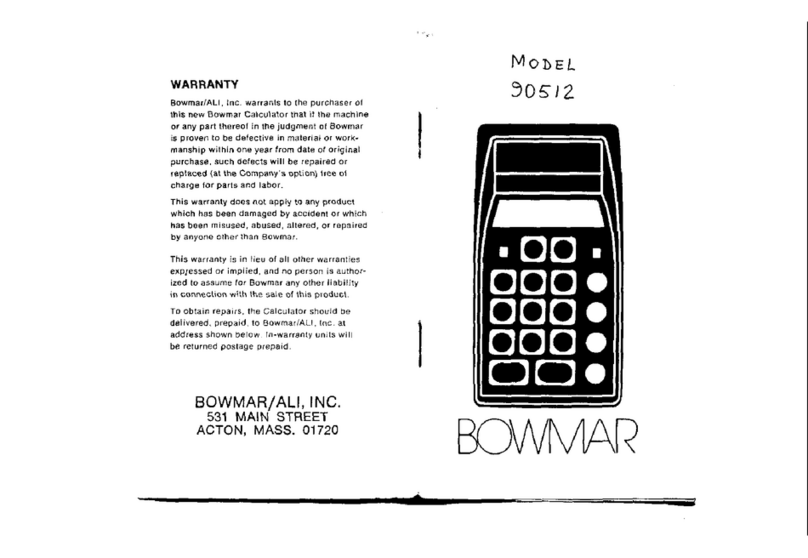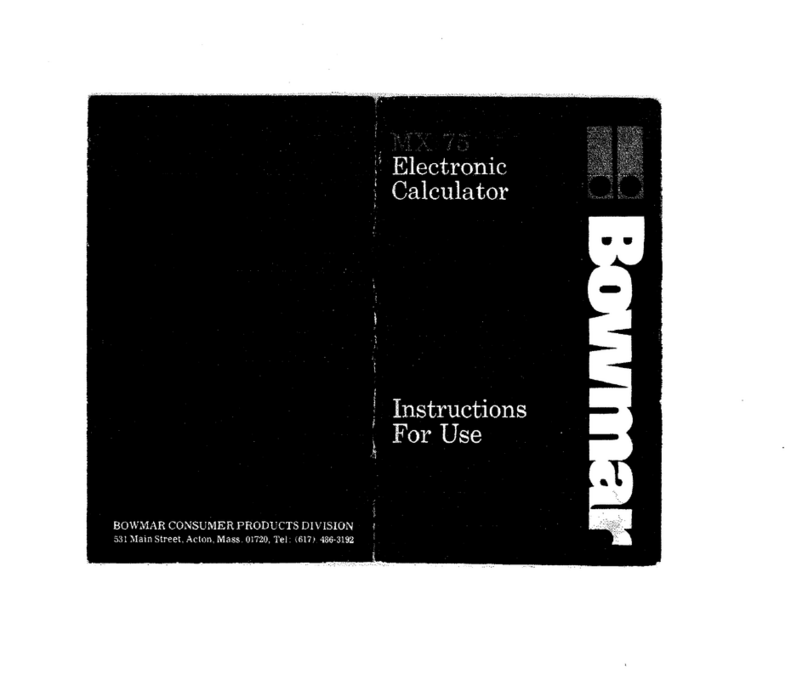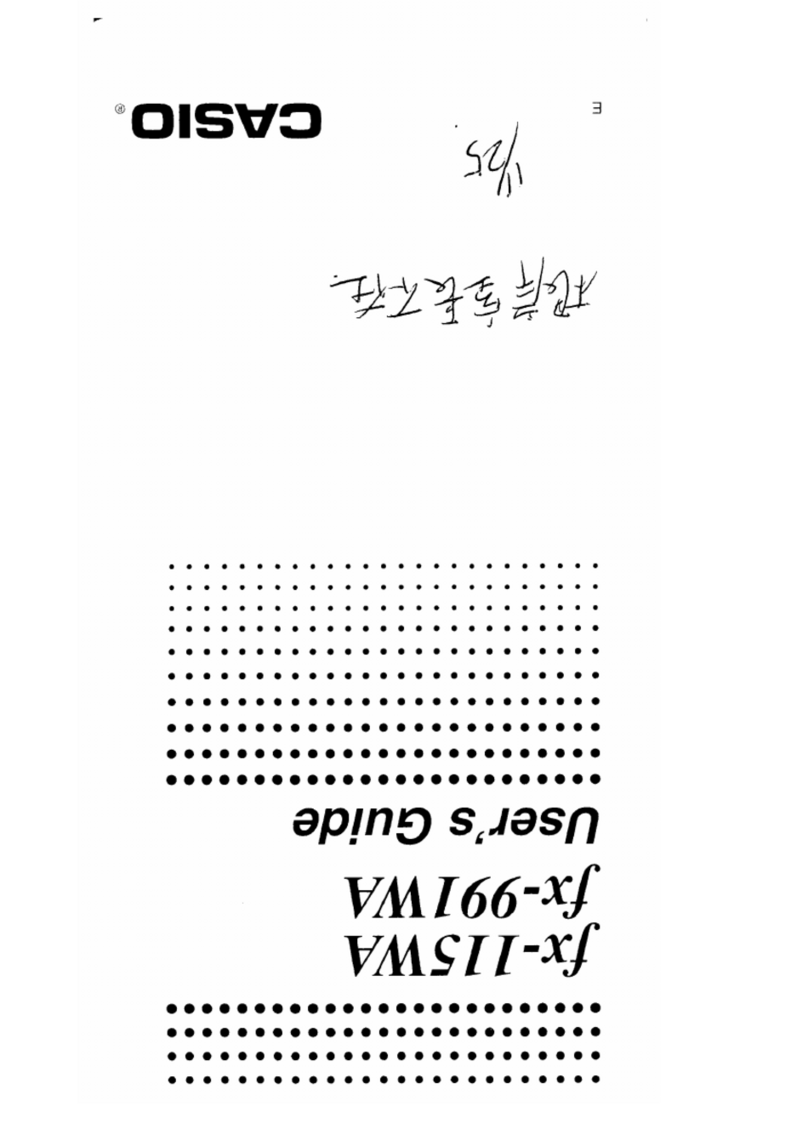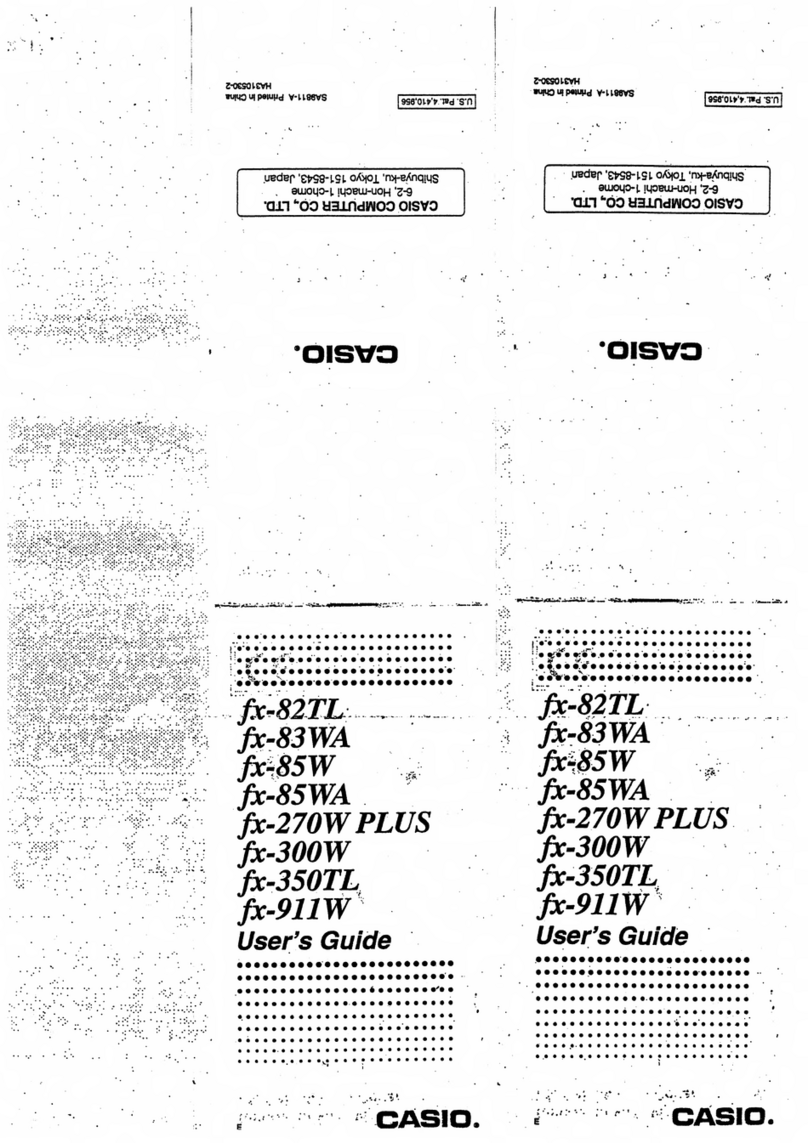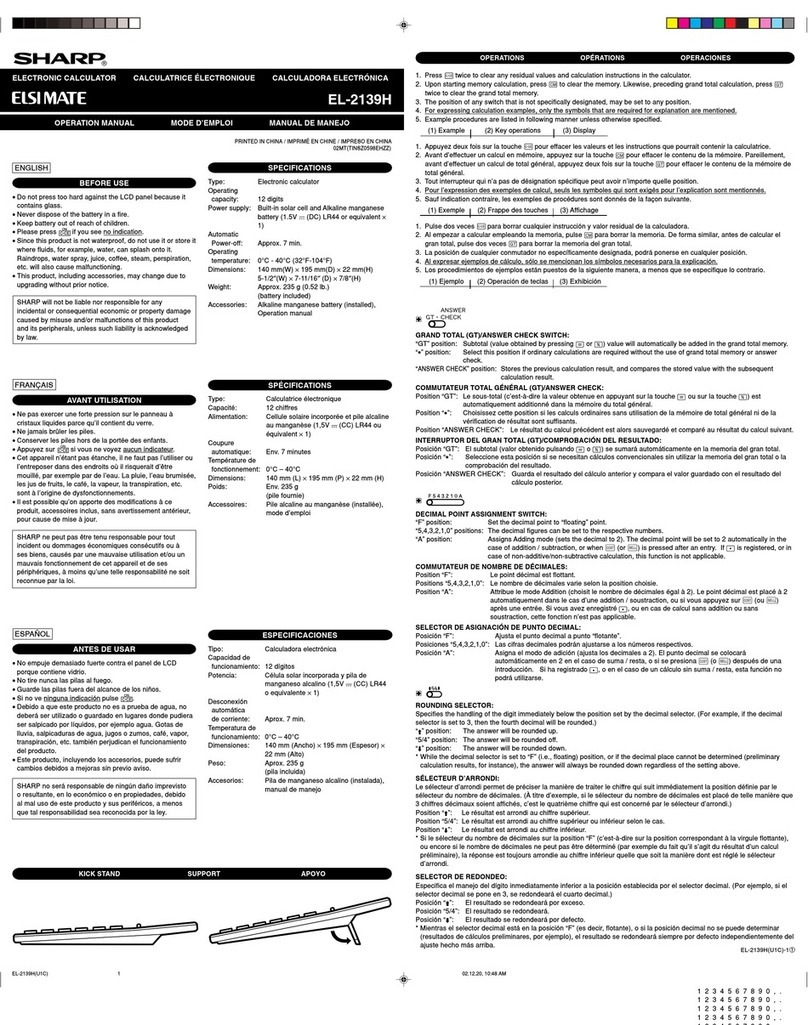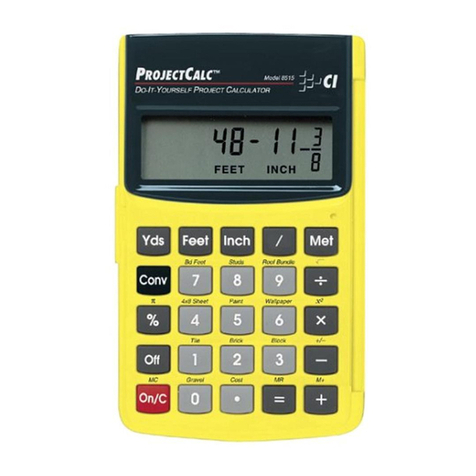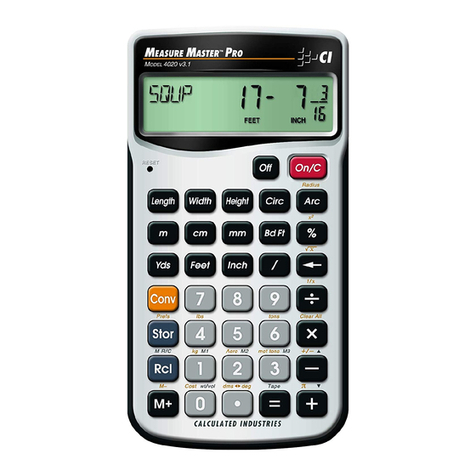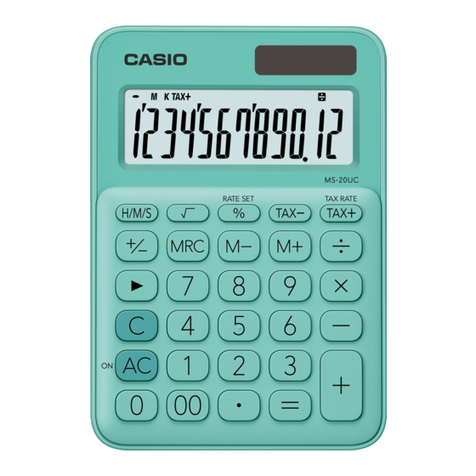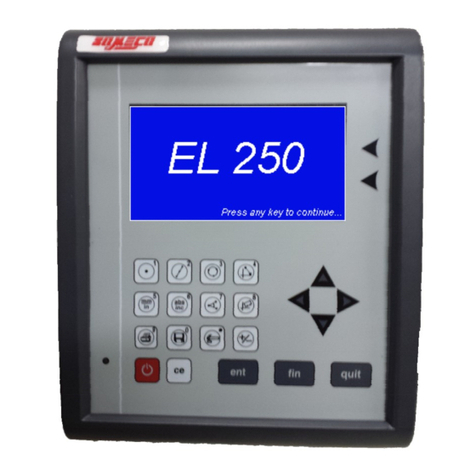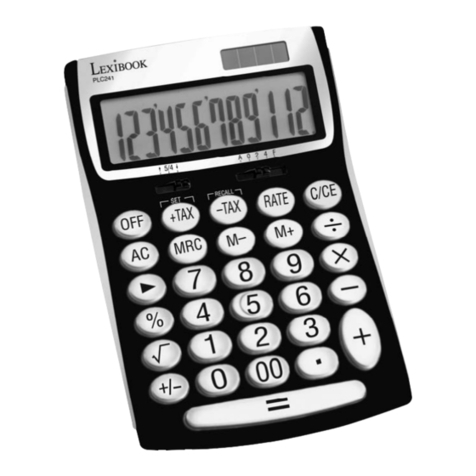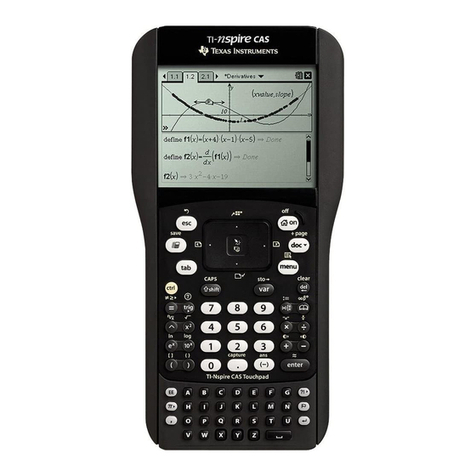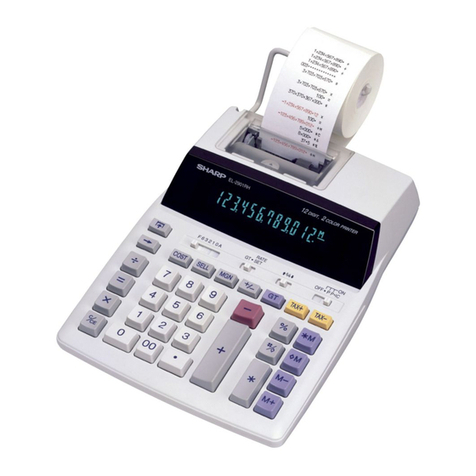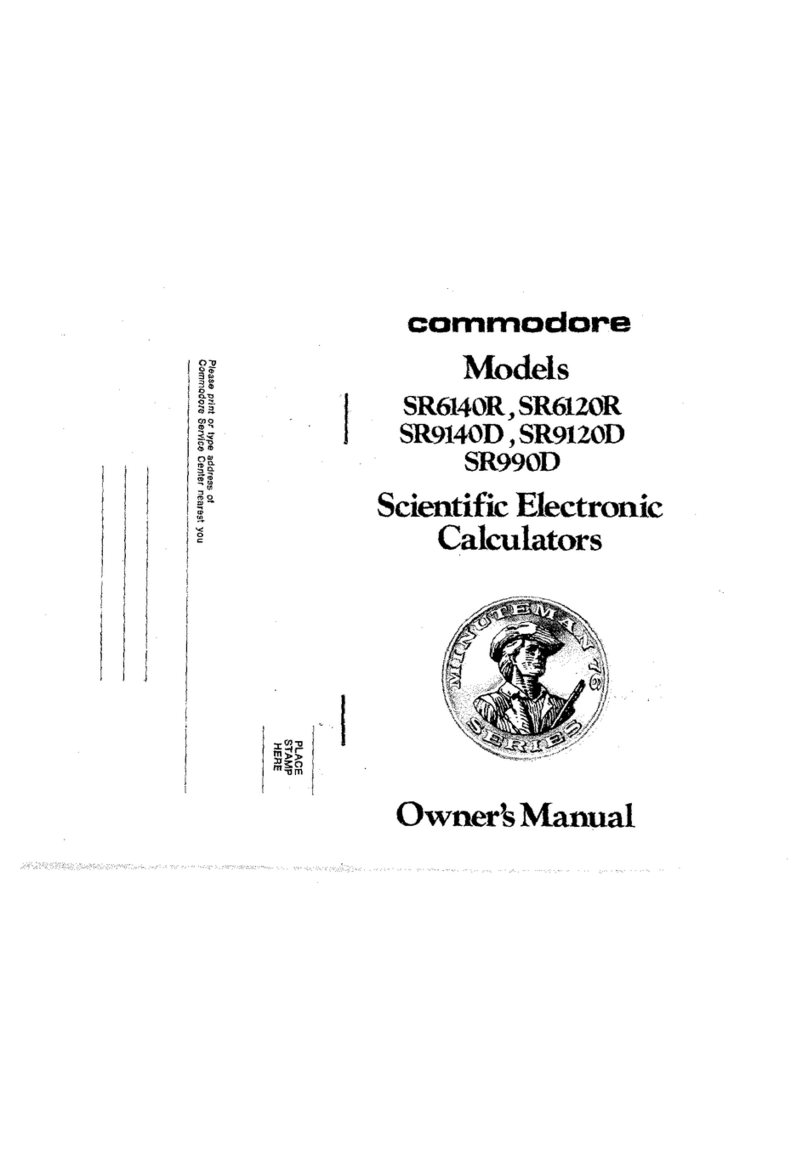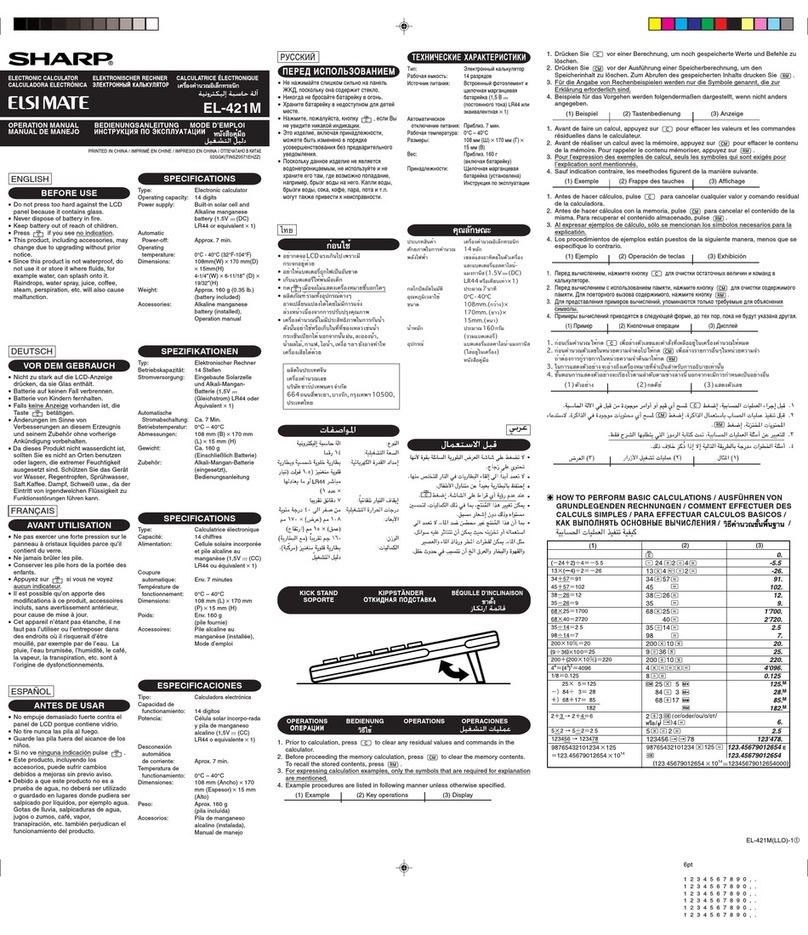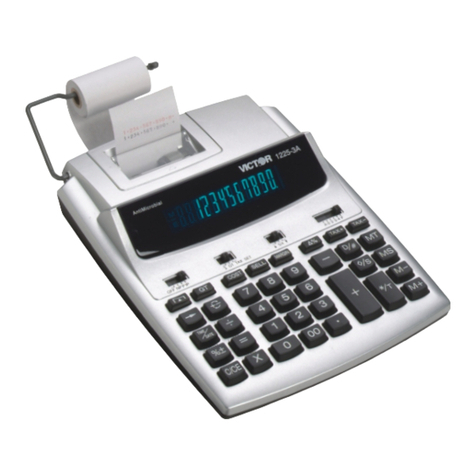Bowmar MX 100 User manual


INTRODUCTION
ihe
Bowmar
MX
100
Scientific
Brain
utilizes
recent
deveiopments
in
solid-staie
integrated
circuitry
to
provide
a
vast
extension
of
conventional
slide-rule
capabilities,
with
far
more
accuracy.
It is
also
more
versatile, and it is
compact
enough
to be
pocketable.
Jt
replaces
tedious
and
eye-straining
correlation
of
finely
inscribed
slide-rule
scales
with
a
simpler
lou
ching
of
buttons
on
a
keyboard.
At
the
same
time,
it
reduces
determination
of
a.
numerical
result
to the
reading
of
the
numeral
directly
from
a
lucid
display,
It
also
supplements
functions
01
a
conventional
log-Iog··decitrig
slide-rule
by
t€3turing
a
memory
that
eases
progress
through
complex
multiple-operation
problems.
Your
new
Brain
operates
in
the
algebraic
mode
and
can
accept
a
numerical
input
of
as
many
as
eight
digits.
It
handles
the
four
basic
algebraic
operations
(addition.
subtraction,
mUltiplication, and
division)
and
those
scientific
functions
listed
below, all
with
full
floating
point.
1. Sine.
cosine,
and
tangent
of
degrees
or
radians
(depending
on
the
setting
of
an
external
switch).
2.
Inverse
trigonometric
functions
of
sine,
cosine,
or
tangent,
3.
Natural
and
common
logarithms
4.
Exponential
functions
(e~)
and
exponential
powers
(yX)
5.
Square
root
(v'x)
and
inverse
(Ijx)
6.
Keys
for
'iT
and
sign
change
1
,l.,lll
'.
J.
1
il.
;"..IdbJL
diU,
t5
U'
,ii!
Ii
'--L.U ,1Ft:

7.
A
key
for
the
exchange
of
contents
of
the
display
te~Jister
(x
regis
tor)
and
working
register
(y
register)
t8
In
addition
!o
these
functions,
your
calculator
has
memory
with
tho
foflowin(J
meaDs
of
access:
1.
A
storage
key
m
tor
storing
a
displayed
numeral
in
the
memory.
2.
A
recall
key
t:!m
for
withdrawing
and
displaying
the
content
of
the rn8mOty
without
losing
it
tram
the
memory.
3.
An
exchange
key
~
tor
8Kchanging
contents
01
the
display
and
memory
registers.
4.
A
memory
Clear
key
mfor
discarding
content
of
the
memof"Y.
Your
calculator
also
features
capability
for
chain
and
automatic
constant
operations>
Its
display
is
right
adjl,.,lsted
with
leadjng
zero
suppression.
With
algebraic
operations,
,
results
of
up
10
sixteen
digits
may
be
obtamed
by
use
of
overflOW
interpretation,
With
scientific
operaEons,
display
results
may
contain
up
to
six
digits.
the
iast
digit
having
a±1
tolerance,
To
realize
the full
potential
of
the
MX-IOO
you
are asked to
carefully
read
the
following
material
and
instruclions.
Optirnum
familiarity
can be
gained
only
through
frequent
use,
and
as a
start
you
are
advised
to
foilow
through
eactl
iJiustralive
instruction
with
your
calcu':ator
in
lwnd,
During
routine
use,
reminders
ot opemt(onal procedures
may
be
obtained
from
the
brief
outline
of
instruciions
ptinted
on
tile
back
of
the
calculator.
2
7,
11
II
£JSL&14
UllIli.tdI
aU)
OPERATION
AC
Operation:
Set
the
switch
on
the
back
of
the
Charger/
Power
Supply
to
the
electrical
outlet
voltage,
i.e.,
115
or
230
Volts.
Plug
the
Charger
into
the
outlet
and
the
connector
into
the
Calculator.
(Note
that
the
connector
(s
k'2yed.) AHer
these
connections,
the
power
switch
may
be
iurned
on
and
operation
started.
Baltery
Operation-
Disconnect
the
Charger
cord
and
turn
the
power
switch
"ON".
With
normal
use
a
lull
battery
charge
cao
be
expected
to
supply
about
<1
hours
of
working
lime.
NOTE: When the
low
battery
indicator
(L)
on
the
display
is
lighted,
do
not
continue
battery
operation.
This
indicates
need
for a
battery
charge.
Use
of
the
Calculator
can
be
continued
during
the
charge
cycle.
Charging
will
continue
whether
calculator
is
on
or
ott.
Battery
Charging:
Simply
to!low
the
same
procedure.
3S
ir.
AC
operation.
The
Calculator
may
be
used
during
the
charge
period
if
desired.
in
order
to
iuily
charge
abaHer·y
which
has
been
completely
discharg€.d,
7
hours
is
required.
In
most
ca$e~".
an
overnight
charge
should
be
adequate.
NOTE·
AIU,ough
no
damage
wiil
r-esl)lt
from
prolonged
periods
winl
tho
Charger
connected,
(t
i'2.
advisable
to
remove
i.he
Charger
when
it
is
not
in
use
or
after
afull recharge cycle.
CAUTION:
To
avoid
possitlle
damage,
use
only the
charger
provided
with
the
calculator.
,:;::..\J£LJUIL.lI£,!
(it.U;;
$IIU
h
,.
a
LJ.t1
"
..
M._.£.;

5
CONTROLS &INDICATORS
NOTE:
Descriptions
that
follow
wili
be
beller
understood
jf
you
take
a
moment
to
learn
these
basic
facts.
First,
two
separate
registers
are
provided
for
retaining
the
numbers
you
enler
into
the
Calculator
for
an
aritt,metic
oper"atlon.
One
is
the
Display
Register
which
is
aiso
refened
to as
the
x
Register.
The
other
is
Working
Register
or
y
Register.
Any
number
you
enter
is
keyed
direcily
into
the
Display
IX
Register)
for
yOU!
visual
review.
This
entry
is Hlen
completed
wrlen
you
key
in
the
appropriate
arithmetic
operative
(+,
-.
x,
or
_C-_).
As
you
begin
to
enter
the
second
number,
ttle
first
is
automatically
transferred
fom
the
x
Register
to
the
y
Register.
The
y
Register
retalns
this
first
number
until
you
clear
it
or
you
exchange
contents
of
the
x
and
y
Registers
by
means
of
a
special
key
provided
for
that
purpose.
Second,
your
Calculator
Keyboard
was
designed
for
a
minimum
of
keys
in
order
to
pro'liide
optimum
fingertip
access
within
conven'lent
confines.
This
feature
was
enabled
by
incorporat-
ing
a
block
of
dual
purpose
keys
that
work
in
conjunction
with
an
electronic
"shift"
system.
Ttle
electronic
"shit\"
of
your
calculator
compares
with
the
shift
of
a
typewriter.
Your
calculator
responds
10
the
characters
on
the
keys
in
its
unshifted
mode,
and
it
must
be
shifted
each
time
a
keyis
to
be
operated
for
a
function
printed
above
a
key.
The
calculator's
shift
key
is
\dent(Hed
by tile lettel' ··F". ReIer to tile sec!Ion
of
PRELIMINAi1Y
INSTRUCTION
for
details
of
dual
purpose
Keys.
-5.
4
..
~=-
3.
I.J
Jii
2£
,j
2_
b4
w

1.
"ON"
Switch
Atwo
position
sllde
switch
that
turns the
Calculator
"ON"
&
"OFF".
e'
o
enters
'1' Raises e(2.71828) to
power
of
x
shown
on
the
Display, up to a
limit
of
x=18.42.
3. Keyboard
25 keys that
may
be
categorized
into
groups
of
data keys,
arithmetic
operation
keys,
memory
operation
keys, and
command
function
keys as
tollows:
A.
Data Funclion Keys (all
are
dual-purpose
and
labelled
ac.cordingly.
Character
mode
refers to label on keyface,
while
Function
mode
refers to label
situated
directly
above key.)
enters
'6'
Computes the arc-
tangent, in degrees
or
radians,
of
any
displayed
number
whether
positive
-,
or
negative.
,
enters
'2'
Computes
the
natural
logarithm
of
any
displayed
number
greater
than zero.
Error
condition
is
set
for
a
negative
number.
enters
'3'
Computes
the
logarithm
(base 10) of
any
displayed
number
greater
than zero.
Error
condition
is set
for
a
negative
number.
enters
'4'
Computes
the
arcsine, in
degree
or
ra.dians,
of
any
displayed
number
from 0to
±1.
Error
condition
is set
tor
any
other
number.
enters '5' Computes the
arcosine,
in degrees
or
radians,
of
any
displayed
number
from 0to
:±:1.
Error
condition
is set
for
any
other
number.
LNX
EJ
SIN-T
D
COS-T
D
LOG X
D
Atwo
position
slide
switch
that
selects
degrees
or
radians
for
the
expression
of
angles.
6
Function
Mode
Computes
square
root
of
a
displayed
number
that
is
greater
than zero.
Error
condition
is
set
for
a
negative
number.
enters '0'
Computes
reciprocal
of
a
displayed
number.
Error condition
is
set for
a
display
of zero.
Ilx
l:)
Character
Key
Mode
\/i
enters
'.'
a(decimal)
2.
OEG/RAD
Switch
2
ElE
g4SIil4i1JS£Jli
.CJ
iL
i.
1i2J]Jl!
,.ALa
.it)(
11Q.
_
A$.iP
"Ja

B.
Arithmetic Operation Keys
C.
Memory Operation Keys
Clears
the
Memory
to
zero.
Completes
previous
operation
and
sets
divide
command.
Completes
previously
entered
add,
subtract,
mu(tiply,
divide
or
y'"
instruction.
•
Adds
the
Displayed
number
to
the
content
of
the
memory
and
stores
the
sum in the
memory.
Displays
the
content
of
the
memory.
The
content
of
the
memory
is
not
lost
with
this
operation.
Exchanges
contents
of
the
x
{Display}
Register
and
the
Memory.
D.
Command Function Keys
Completes
the
previous
operation
and
sets
add
command.
enters
'7'
Computes
the
sine,
with
proper
sign,
of
any
displayed
angle,
whether
in
degrees
or
radians
and
whether
positive
or
negative.
enters '8' Computes the cosine,
with
proper
sign,
of
any
displayed
angle,
whether
in
degrees
or
radians
and
whether
positive
ar
negative.
enters
'9'
Computes
the
tangent,
with
proper
sign,
of
any
displayed
angle,
whether
in
degrees
or
radians
and
whether
positive
or
negative.
a
SiN
D
cos
D
TAN
D
EJ
Completes
the
previous
operation
and
sets
subtract
command.
Completes
previous
operation and sets
'multiply'
operation.
S
During
an
entry
it
clears
the
entry
with
single
depression.
For
all
other
operations,
it
clears
all
registers
except
the
memory
register
with
single
depression,
9
II.
£Si. ••

a
It
clears
the
overflow
sign with
single
depression.
Enables a
number
yto
be
raised to a
power
x
(see
pertinent
Instructions)
.
Shifts
between
Function
and
Character
Modes
ot
dual-purpose
keys.
A
dual-purpose
key
that
changes
sign
of
the
Displayed
number
in the
Character
Mode,
and
displays
7T (3.1415926)
in
the
Function
Mode.
5.
6.
Decimal
Point
Indicator
Function
Mode
indicator
Automatically
appears to
the
right
of
any
number
entered, unless
inserted
in
another
sequence
by
use
of
the
Decimal
key.
Confirms
shift
of
dual
function
keys from
Character
to
Function
Mode.
Appears as:
Charger
Cord
Socket
Charger/Power
Supply
.'0,
11
2.
To
clear
an
incorrect
entry
Example:
48
+
12
\s
your
calculatlon
A.
You have already entered
48
-t
Display is',
1. To
clear
for
new
operation
A.
Touch the
~
key
two
consecutive
times
to
clear
all registers
B.
Cleared
display
will be:
PRELIMINARY INSTRUCTIONS
Exchanges
contents
of
x
and
yRegisters.
Indicates a
condition
or
computation
that
the
Calculator
is
not
intended for or cannot
perform.
Also
indicates
Overflow.
Appears
as:
10
Error
and
Overflow
Indicator
4.
low
Battery
Indica\or
Warns
of
need
for
battery
charge
during
battery
operation.
Appears
as:
Minus Sign
Indicator
Appears
as:
dlL
JLCii;
Ji
!.tEUS
$t
JtJ
LUi!

In
algobraic
form,
these
computations
are:
16,3
4,
296)
438
2.
438
-296
~
4.
438
'0'
296 ~
3.
438
x296
2.
438
~
296
1.
438
+2\}6
1. 438 +296 =
3, 438 x296
~
C.
Results
of
more
than
eight
but
less
than
seventeen
digits
will
appear
with
the
overflow
Indicator
(described
under Conlrols &Indicators).
See
Instructions
for
Overflow
I
nte
rp
retal
ion.
4.
To
enter amathematical computation
Entry
of
a
computation
is
greatly
simplified
when
it
is
first
converted
to
algebrnic
form.
These
computations
are then
entered
a
digit
or
operative
at
a
time,
beginnIng
with
the
left-most
figure
and
progressing
to
the
right
For
full
detalls
refer
to
specific
instructions
and
examples
that
follow.
5. Reading anumerical result
A.
Results
01
etght
digits
or
less
are
read
directly
from the
Display.
B.
In
certain
computations,
zeroes
at
the
extreme
right
of
a
decimal
result
will
be
suppressed.
For
example,
a
result
representing
S16.30
may
appear
as:
B.
Then
you
enter
13
ins.tead
of
12.
Display
is:
123.45
A
mistake!
C.
To
clear
13,
touch
the
~
key
once
only.
Display is:
D.
Then
enter
12.
Display is:
E,
Finally,
touch
the
II
key
for
answer.
Display
'IS:
NOTE:
An
~ncorrect
entry
should
be
cleared
prior
to
any
other
entry
or
operation.
3.
To enter anumber
Example: enter 123.45
A.
Starting
with
the
left-most
digit
touch
keys
as
follows:
1,2,3,
.,
4,
and
5.
B.
Display
will
be:
12
I_
XU
h.
.2
!
_.
:
Ii.
-La Q

9.83
26.22
16.39
16.39
Answer
c.
Touch
a
b.
Enter
16.39
d.
Enter
9.83
e.
Touch
I!I
SAMPLE
CALCULATIONS
ADDITION
Example
#1: To calCUlate 16.39 +9.83 "=
Do
these
steps
display
will
be
a.
Touch
~
twice.
Ex.ampte
~2:
To
calculate
16
+9+8.3 +4.1 "=
00
these
steps
display
will
be
3.
Touch
k1I
twice
e.
Touch
a
b.
Enter
16
c.
Touch
II
d.
Enter
9
f.
Enter
8.3
6.
Dual
purpose
keys
Dual
purpose
keys
are
identified
by
dual
labels.
One
label
is
directly
on
each
keyface
and
is
referred
to
as
Character
Label.
The
other
label
is
directly
abo\'€
each
key
and
is
the
Function
label.
Thus,
the
dual
labels
suggest
operation
in
either
the
Character
Mode
or
the
Function
Mode.
Normally
the
Calculator
responds
directly
to
the
Character
Mode
of
a
dual
purpose
key.
The
response
may
be
shifted
to
the
Function
Mode
by
first
touching
the
iii
key.
Touching
the
D
key
shilts
Calculator
response
to
the
Function
Mode
for
the
operation
of
one
dual
purpose
key
only.
Each
subsequent
use
of
Function
Mode
must
be
preceded
by
operation
of
the
o
key.
When
the
D
key
is
touched
to
shift
Calculator
response
to
the
Function
Mode,
a
corresponding
Function
Mode
indicator
appears
on
the
Display,
Note
that
the
Character
Mode
may
then
be
re-established
either
by
retouching
lhe
D
key
or
by
completing
a
Function
Mode
operation.
1a
-',ijULL.MJ &
AUIB.!
;;
II
14#£._
Ii
,.
tXt
iJ
g.
Touch D
h.
Enter
4.1
i.
Touch
m
L
?'ill
a
Answer
15
--
33.3
.37.4
1!

56.5
29.32
29.32
-50.
-
10.
-20.
a.
Touch
~
twice
a,
Touch
W
twice
b,
Enter
29.32
c.
Touch
EI
d.
Enter
56.5
1)
d.
Enter
82
e.
Touch
II
f.
Enter
10
g.
Touch
a=I
h.
Enter
40
I.
Touch
a
Answ€r
MULTIPLICATION
Example ::6
To
calculate
29.32 x
56.5
"".
Do
these
steps
display
will
be
c.
Touch
a
Example
ii5:
To calculate 62 -82 +10 -40 =
Do
these
steps
display
will
be
b.
Enter
62
9.21
19.1
14.1 '
12.81
12.81
-5~
display
wU\
be
Answer
SUBTRACTION
Example ;'3: To calculate 12.81 -3.6 =
Do these'Tsteps
display
will
be
a.
Touch
~
twice
Example ::4:
To
calculate
23 -6+2.1
Do
these
steps
a.
Touch
fi.J1
twice
b.
Enter
12.81
c.
Touch
a
d.
Enter
3.6
e.
Touch
III
Answer
c.
Touch
II
d,
Enter
6
e.
Touch
a
I.
Touch
a
b.
Enter
23
1.
Enter
2.1
g.
Touch
a
h.
Enter 5

8.
Touch
II
Answer
1656.58
3.
0.1111111
0.3333333
1
1 .
'_
DISPLAY
WILL
READ
for for
for
subtract
multiply
divide
to
get
REPEATED OPERATIONS
Example #8:
Arithme1ic operations (add,
subtract.
mUltiply, and divide) may be repeated on a
single
r1umber
as
follows
(using
1he
number
3
as
an
example).
Initial steps
for
each
operation
are
a.
Touch
W.
1wice to
get
b.
Enter
3
then
do
these
steps
c.
Enter
a
3. 3.
3.
or
I
II
or
13
!
or
.,
II
•,,
~
..
...
rl
TOUGlliiI
.-0.
0
9."
e.
Touch
II
9.
-3.
27.
f.
Touchll
12.
-6.
81.
g.
etc.
b.
Enter
81
c.
Touch
II
DIVISION
Example #7: To calculate
61
-+-
3
-+-
9=
Do these steps
display
will be
a.
Touch
~
twice
f.
Enter
9
g.
Touch
II
Answer
d.
Enter
3
e.
Touch
II
18 19
;;

N+
Y.
N+
X.
.2N.
. N +Z.
display
will
be
,
CONSTANT OPERATIONS
Addition,
subtraction,
mutipfication,
and
division by a
constant
may
be
performed
as
follows
(using the
number
'N'
as the
constant).
A.
Addition
Ex.ample #10:
Do
these steps
a.
Touch
~
twice
b.
Touch
a
c.
Enter N
d.
Touch
iii
e. Entor the
number
X
f.
Touch
Ell
g.
Enter the
number
Y
h.
Touch
iii
i.
Enter the
number
Z
}
j.
lauen
iii
k.
etc.
IB.
Subtraction
Example
#11
:
a.
Touch
~
twice
b.
Enter
2N
21
j
I
.15.
1436.
1485.
. . 37.789473'
20
Do
these
steps
a.
Touch
~
twice
b.
Enter
73
c.
Touch a
d.
Enter
26
e,
Touch
E:I
f. Enter 15
g.
Touch
II
h.
Enter
49
LTouch
II
J.
Enter
38
k.
Touchl!"-
Answer
CHAIN OPERATIONS
(Mixed
Arithmetic)
Example #9:
To
calculaltiI3+26)
15..-::,_49,_
38
-
display
will
be

YIN.
XIN.
23
b.
Enter
32
degrees
FUNCTION OPERATIONS
Iuslng gkey)
I
Trigonometric
Function
All
trigonometric
functions
may
be
performed
in
degrees
or
radians,
as
determined
by
posltioning
of
the
DEG/RAD
switch.
A.
Sine
Example #14:
To
obtain
SIN 320
(set
the
DEGjRAD
switch
to DEG)
Do
these steps
display
will
be
a.
Touch
~
twice
D.
Division
Example
#13:
a.
Touch
~
twice
b.
Enter
m
c.
Touch
II
•m
d.
Enter
e.
Touch
II
f.
Enter
the
number
X
g.
Touch
II
h. E:nter
the
number
Y
i.
Touch
II
j. etc.
2t
$if
NxZ.
Y-
N.
x-
N.
a
/ '
Y.
h.
etc.
c.
Touch
EI
C.
Multiplication
Example
,~12:
a.
Touch
t1I
twice
d.
Enter
the
number
Y
e.
Touch
II
f.
Enter
the
number
Z
g.
Touch
II
12
_ J i
b.
Enter
N
j.
etc.
c.
Touch
a
!.
Touch
II!
e.
Touch
iii
d.
Enter
N
f.
Enter
the
number
X
g.
Touch
II
h.
Enter
the
number
Y
-

0.848048
\32.
Answer
c.
Touch
iii
cos
d,
Touch
D
b,
Entor
32
degrees
a.
Touch
t"i
twice
B. Cosine
Example
;17:
To
obtain
COS
32°
(set the
o'EG/RAD
switch
to DEG)
Do
these steps
display
will
be
0.529919
.4.4157
\32.
Answer
a.
Touch
~
twice
b.
Enter
4.4157
G.
TOUGh
D
SIN
d.
Touch
Ii
Example #15:
To
obtain
SIN
4.4157
radians
(set the DEG/RAD
switch
to RAD)
Do these steps
display
will
be
Example
(:16:
To
obtain
SIN
(-198°)
(set the
DEG/RAD
switch
to DEG)
Do these
steps
display
will be
b.
Enter 198 degrees 0.624869
Answer
C,
Tangent
Example
#18:
To
obtain
TAN
32°
(set
the
DEG/RAD
switch
to
DEG)
Do these steps
display
will
be
a.
Touch
~
twice
c.
Touch
Ii
TAN
d.
Touch
I]
b.
Enter
32
degrees
198.
-0.95631
\4.4157
Answer
a.
Touch
W.
twice
G.
TOUGhl]
SiN
d.
TOUGhS
c.
Touchm,
d.
TOUGhl'il
SiN
e.
TOUChD
Answer
-198.
-: 198.
0.309017
\I
Inverse
Trigonometric
Functions
(degrees
or
radians)
A.
Arcsine
Example
,';"19;
To
obtain
SIW'
0.529919
(set
the
DEG/RAD
switch
to
DEG)
Do
these
s'\eps
display
wii!
be
a,
Touch
~
twice
-
;,
;
24
_
i.
'-
_
iJ.4.
b.
Enter .529919
.L
25
;
,0.529919
.'

B.
Arcosine
Example
;;21:
To
obtain
COS-
10.848048
in
Radians
(set the
DEG/RAD
switch
to RAG) ,
Do
these
steps
display
will
be
2.32
2.32
0.624869
31.99999
0.098274
\0.624869
-2.32
-2.32
display
will
be
C.
Arctangent
Example
#22:
To
obtain
TAN-)
0.624869
(set the
DEG/RAD
switch
to
DEG)
Do these steps
display
will
be
b.
Enter
.624869
a·
Touch
~
twice
III
Exponenflal
Function
Example
/:23: To
obtain
e
Do
these
steps
a. Touch
~
twice
c.
Touch
II
TAN-1
d.
Touch DDegrees
b.
Enter
2.32
"
c. Touch
~
d.
Touch
IJ
e'
e.
Touch D
Answer
0.848048
0.558505
.31.99998
'.
0.529919
-;
31.99998
",.
0.529919
-.:
0.529919
\0.848048
\ 1 0.529919
Degrees
c.
Touch
iii
COS-
1
d. Touch DRadians
Th
lB3
twice
a.
auc
£!I
b.
Enter .848048
c.
Touch
~
d. Touch D
SIN-l
e.
Touch a
b. Enter
.529919
a.
Touch
~
twice
c.
Touch
iii
SIN-l
d.
Touch aDegrees
Example
;20:
To
obtain
SiN-I
(-
0.529919)
Iset
the
DEG/RAD
switch
to DEG)
'b
Do these
steps
display
will
e
26
27
-",
__
:
.'
•.•
'.l.'
__
....
....
:
.2.Ji2i!U"··-
••
,.J
••
I!il¥I!ilUI!il.
_

IV
Natural
Logarithm
Example
i24:
To
obtain
In
5·623 .
00
these
steps
display
will
be
638.72
0.0015656
3.1415926
\638.72
display
will
be
,
Answer
b.
Enter
638.72
VII
Reciprocal
Example
#27:
To
obtain
the
reciprocal
of
638.72
Do
these
steps
display
will
be
a.
TaUCrl
~
twice
c.
Touch
Q
1/'
d.
Touch
D
VIII
Pi
(ee)
Example
:::28:
To
obtain
a
numerical
readout
for
the
constant
7..
Do
these
steps
a.
Touch
~
twice
b.
TOUCh
D
"
c.
Touch
t:.m
Answer
EXPONENTIAL POWER
5.623
4.83
0.683947
1.726866
\4.83
\5.623
c.
Touch
D
lOGX
d.
Touch
EJ
Answer
b.
Enter
4.83
a.
Touch
~
twice
b.
Enter
5.623
c.
Touch
D
LNX
d.
Touch
B
Answer
V
Common
Logarithm
Example
:(25: To
obtain
log\o 4.83 ,
Do
these
steps
display
will
be
a.
Touch
~
tWice
VI
Square
Root
Example
::26:
To
obtain
"\/341.57
Do
these
steps
display
will
be
$r
3.555349
87300.83
Answer
29
Example #29:
To
obtain
(35)3-2
Do
these
steps
display
will
be
a.
Touch
~
twice
b.
Enter
35
c.
Touch
m
gives
the
natural log of
35
d.
Enter
3.2
e.
Touch
II
341.57
18.481612
\
341.57
b.
Enter
341.57
c.
Touch
11
\.
x
d.
Touch
II
Answer
28
a,
Touch
~
twice

36.
72.
72.
72.
72.
y
register
31
107.
display
will
be
TRANSFER XAND YREGISTER
CONTENTS
~.~
The
t:i2
key
offers
many
Possibiiities
for
use.
One
of
tt18se offered below.
Example
#30:
The problem 36 +72 has been
entered, and you decide fa change the number
36 to 35. Proceed
as
follows, first
by
entering
the
problem:
ilL]]
Do these steps
8.
Touch
~
b.
Enter
36
c.
Touch
II
d.
Enter
72
g. Enter
35
To
change
36
to
35
8.
Touch
£Ii
f.
Touch
~
once
h.
Touch
IiIAnswer
720.
O.
3j.1
_ - t.¢'
?
O.
O.
250.
250.
550.
550.
550.
670.
670.
670.
670.
670.
670.
720.
670.
_R
720.
120.
300.
120.
300.
670.
250.
300.
250.
36000.
itt
1
J!
Answer
display
will
be
twice
,
MEMORY OPERATIONS
The
following
exercise
is
aimed
at
fami!arizing
you
with
memory
operations
and
capability.
memory
will
contain
Do
these
steps
a.
Touch
m
b.
Touch
em
c.
Enter 250
d.
Touch
~
e.
Enter
300
t
louch
2
g. Touch
EI
h.
Enter
120
i.
Touch £
jTouch
II
k.
Enter
50
I.
Touch a
m.
Touch
1m
n.
Touch
II
o.
Touch
E3
p.
Touch
1;1
q.
Touch
1m
-
l.
-"
..
;.
LX

0.30103
2.302585
1.999999
Example
i32:
find the antilog
of
.30103 (base 10)
A,
One way is to raise 10 to the
power
of
the
logarithm
as
follows:
Do these steps
display
will
be
a.
Touch
~
twice
b. Enter
10
c.
TouCh
!iI
(gives
natural
log
of
10.)
d.
Enter .30103
e.
Touch
DAnswer
0.0652173
b.
Ellter
3
c.
Touch
II
d.
Enter
46
e.
Touch
n
MIXED PROBLEMS
Example ':31: do 36 +9
.-
_.-
=
8+~_
46
Do these steps
display
will be
a.
Touch ril
o.
O.
o.
O.
O.
-58.
memory
will
hold
-58.
-58.
display
will be
~~x~amrjP~le~.~-:-3J3~:fdIO~~ffi13:~=]~
)36
(36
43)(36
15)
(36 94)
~
36
Do these
steps
a.
Touch
m
twice
b.
Touch;a
c.
Enter
36
d. Touch a
e.
Enter
94
f.
Touch
II
g.
Touch
=:
37.115902
1.1159028
8.0652173
I.
Touch a
m.
Enter 36
n.
Touch
!lAnswer
II'
i. Touch
r!I
J.
Touch
EI
k.
Enter 9
f.
Enter 8
g.
Touch
II
h. Touch
I]
32

o.
O.
0.829037
0.687303
0.684
0.687303
0,4701152
0.5298848
-0.18749
\56.
-0,4701152
-0,4701152
15.38939
2
35
:
aa.
Enter
36
bb.
Touchlil
Answer
Example #34: do
/1
-O.684SIW 560=
Do
these steps
display
will
be
a.
Sot
DEG/RAD
switch
for
DEGREES
b,
Touch
~
twice
c.
Enter
56
0.
Touch
13
SIN
e.
Touch
fJ'
f.
Touch
~
g, Enter 2
h. Touch
II
j, Touch
EI
J.
Enter
.684
k.
Enter
II
I.
Touch
I!
m.
Touch
D
n.
Enter 1
o.
Touch iii
o.
o.
o.
o.
o.
o.
, .
Ail
1
Qt
-1218.
-1218.
-1218.
-1218.
-1218.
-1218.
-58.
-58.
-58.
-58.
-58.
-58.
-1218.
'JJi,
1.
306936.
554.01805
306936.
.36.
8526.
.36.
.15.
- .
7.
-1218.
-58.
-1218.
-58.
h. Enter
36
i.
Touch
II
J.
Enter
15
k.
Touch
13
I.
Touch
t!iliI
m. Touch
iii
n.
Toucht!3
o.
Touch
~
p. Enter 36
q.
Touchll
r.
Enter
43
s.
Touch
EJ
t.
Touch
t!iliI
u.
Touch
13
and
im
v.
Enter
36
w.
Touch
II
x.
Touch
III
\i
X
y.
Touch a
z.
Touch
II
....
b.;.
.1
,j,
Iti
;dO

•
0.0144792
0.0144792
0.0144792
0.0144792
0.0144792
0.0144792
0.0144792
0.9851475
0.992546
0.992546
0.9778042
0.9778042
0.0144792
o.
Touch
Ii
cos
p.
Touch
a
q.
Touch
EI
r.
Touch
II
s.
Touch
II
t.
Touch
13
u.
Touch
liiJ
r42676.292
v.
Touch
IIAnswer
0.0144792
OVERFLOW INTERPRETATION
The
positive
or
negative
overflow
indicator
indicated
by
r
or
(
,respectively,
will
appear
when
the
dIsplay
capacity
of
the
calculator
is
exceeded.
For
example,
multiplication
of
two
positive
numbers,
12345678 x345678
will
give
the
following
display
The'
r'
symbol
indicates
positive
'overftow'
and
indicates
an
answer
of
more than B
digits
shown.
To
obtaIn
the
correct
decimal
location
for
either
case,
simply
record
the
displayed
number
and
move
the
decimal
polnt
8
places
to
the
right.
The real
answer
will
then
be:
4,267.629.200,000.
L 8
places
..
j
This
procedure
applies
to
all
operations.
Use the
akey
to
clear
the
overflow
.
11
.J
L2
o.
o.
o.
O.
O.
O.
O.
O.
o.
o.
,UJ;
H;
0.0144792
0.0144792
0.014852
0.121869
0.121869
0.0144792
0.0144792
36
~
o.
\0.5298848
0.7279318
memory
display
will
be
will
hold
a.
Set
DEGjRAD
switch
to
DEGREES
d.
Enter
7
b.
Touch
~
twice
c.
Touch
m
p.
Touch
iii
Vi
q. Touch
IJAnswer
Do
these
steps
e.
Touch
iii
SIN
f.
Touch
D
g.
Touch
EI
h.
Touch
I!I
i.
Touch
II
J•
Touch
EI
k.
Enter B
I.
Touch
I!I
m.
Touch
m
n.
Enter
7
.....
,
!L
I.
Table of contents
Other Bowmar Calculator manuals

